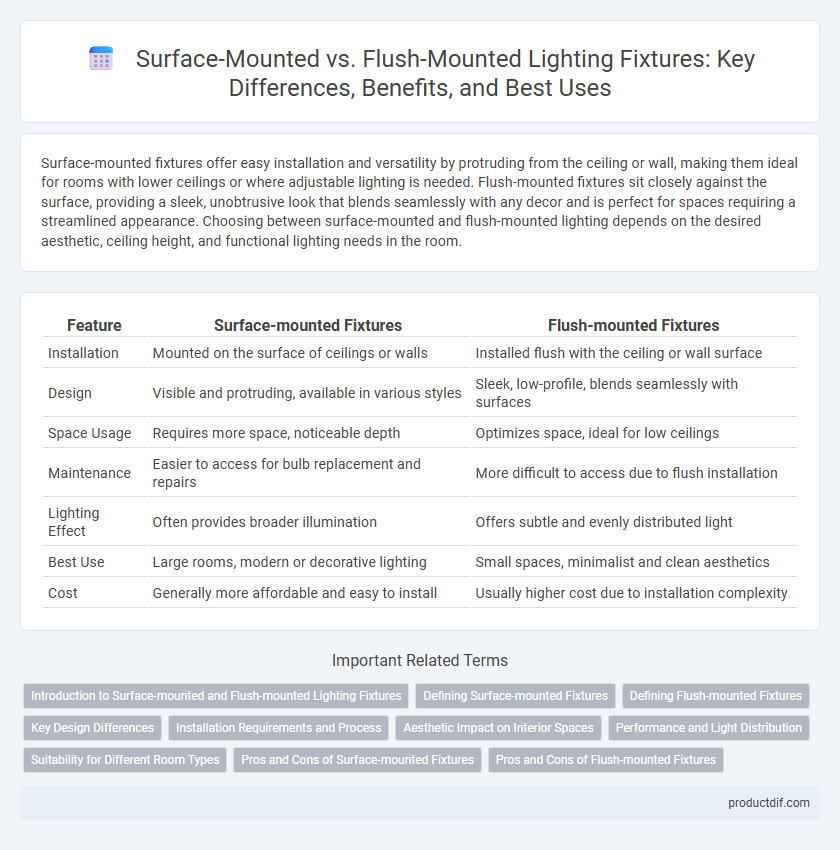Surface-mounted fixtures offer easy installation and versatility by protruding from the ceiling or wall, making them ideal for rooms with lower ceilings or where adjustable lighting is needed. Flush-mounted fixtures sit closely against the surface, providing a sleek, unobtrusive look that blends seamlessly with any decor and is perfect for spaces requiring a streamlined appearance. Choosing between surface-mounted and flush-mounted lighting depends on the desired aesthetic, ceiling height, and functional lighting needs in the room.
Table of Comparison
| Feature | Surface-mounted Fixtures | Flush-mounted Fixtures |
|---|---|---|
| Installation | Mounted on the surface of ceilings or walls | Installed flush with the ceiling or wall surface |
| Design | Visible and protruding, available in various styles | Sleek, low-profile, blends seamlessly with surfaces |
| Space Usage | Requires more space, noticeable depth | Optimizes space, ideal for low ceilings |
| Maintenance | Easier to access for bulb replacement and repairs | More difficult to access due to flush installation |
| Lighting Effect | Often provides broader illumination | Offers subtle and evenly distributed light |
| Best Use | Large rooms, modern or decorative lighting | Small spaces, minimalist and clean aesthetics |
| Cost | Generally more affordable and easy to install | Usually higher cost due to installation complexity |
Introduction to Surface-mounted and Flush-mounted Lighting Fixtures
Surface-mounted lighting fixtures are installed directly onto the ceiling or wall surface, offering easy access for maintenance and a variety of design options. Flush-mounted fixtures sit tightly against the surface, providing a sleek, streamlined look ideal for low-clearance areas. Both types optimize lighting efficiency while catering to different aesthetic and functional needs in residential and commercial spaces.
Defining Surface-mounted Fixtures
Surface-mounted fixtures are lighting installations attached directly to the ceiling or wall surface, creating a visible housing that protrudes into the room space. These fixtures are ideal for rooms with standard or low ceiling heights, offering easy installation and maintenance without the need for recessed mounting. Common examples include ceiling-mounted LED panels and wall sconces that provide efficient illumination while enhancing room aesthetics.
Defining Flush-mounted Fixtures
Flush-mounted fixtures are lighting installations designed to sit directly against the ceiling or wall surface, creating a seamless, streamlined appearance without any gaps or protrusions. These fixtures are ideal for rooms with low ceilings or where a minimalist aesthetic is desired, providing discreet, evenly distributed illumination. In contrast to surface-mounted fixtures, flush-mounted options integrate seamlessly with architectural elements, enhancing spatial harmony while typically housing LED or compact fluorescent light sources for energy efficiency.
Key Design Differences
Surface-mounted fixtures protrude from the ceiling or wall, offering easy installation and a more prominent visual impact suited for rooms with standard or low ceilings. Flush-mounted fixtures sit directly against the surface, creating a sleek and minimalistic look ideal for spaces with low ceiling heights or where a streamlined design is preferred. The choice between surface-mounted and flush-mounted lighting significantly affects room aesthetics, installation complexity, and ceiling clearance.
Installation Requirements and Process
Surface-mounted fixtures require mounting brackets or plates attached directly to the wall or ceiling surface, making installation quicker and more adaptable to various structures. Flush-mounted fixtures need precise cutouts in the drywall or ceiling material, demanding careful measurement and sometimes professional assistance to ensure a seamless, integrated look. Both types necessitate electrical wiring connections, but surface-mounted options typically allow easier access for maintenance and adjustments after installation.
Aesthetic Impact on Interior Spaces
Surface-mounted fixtures create a prominent visual presence, adding depth and dimension to ceilings and walls, often serving as statement pieces in interior design. Flush-mounted fixtures offer a sleek, minimalistic look by sitting closely against surfaces, enhancing clean lines and a streamlined aesthetic without interrupting ceiling planes. Choosing between these fixtures depends on the desired balance between decorative impact and subtle integration within a room's overall design.
Performance and Light Distribution
Surface-mounted fixtures provide greater versatility in light direction and intensity, ideal for spaces requiring adjustable illumination. Flush-mounted fixtures deliver uniform light distribution with minimal shadows, enhancing ambient lighting in lower ceilings. Performance-wise, surface mounts excel in task lighting, while flush mounts optimize overall room brightness and energy efficiency.
Suitability for Different Room Types
Surface-mounted lighting fixtures are ideal for rooms with lower ceilings or spaces requiring adjustable light direction, such as kitchens, laundry rooms, and basements, offering easier installation and maintenance. Flush-mounted fixtures suit areas with standard to high ceilings like bedrooms, living rooms, and hallways, providing a sleek, unobtrusive appearance benefiting rooms with limited vertical space. Choosing between surface-mounted and flush-mounted lights depends on ceiling height, room function, and desired aesthetic, ensuring optimal illumination and spatial harmony.
Pros and Cons of Surface-mounted Fixtures
Surface-mounted fixtures offer easy installation and maintenance since they are attached directly to the ceiling or wall surface, making them ideal for retrofit projects and spaces with limited ceiling cavity. These fixtures provide versatile design options with a variety of shapes and sizes, enhancing room ambiance through customized light diffusion. However, their protruding design can be less aesthetically pleasing in minimalist interiors and may collect dust and debris more easily than flush-mounted alternatives.
Pros and Cons of Flush-mounted Fixtures
Flush-mounted fixtures create a sleek, unobtrusive look by sitting directly against the ceiling, making them ideal for low ceilings and minimalist interiors. These fixtures are easier to clean and maintain due to their flush design but may offer less light dispersion compared to surface-mounted alternatives. Limited installation options and potential challenges in accommodating larger light bulbs or decorative elements are notable drawbacks of flush-mounted lighting.
Surface-mounted Fixtures vs Flush-mounted Fixtures Infographic

 productdif.com
productdif.com